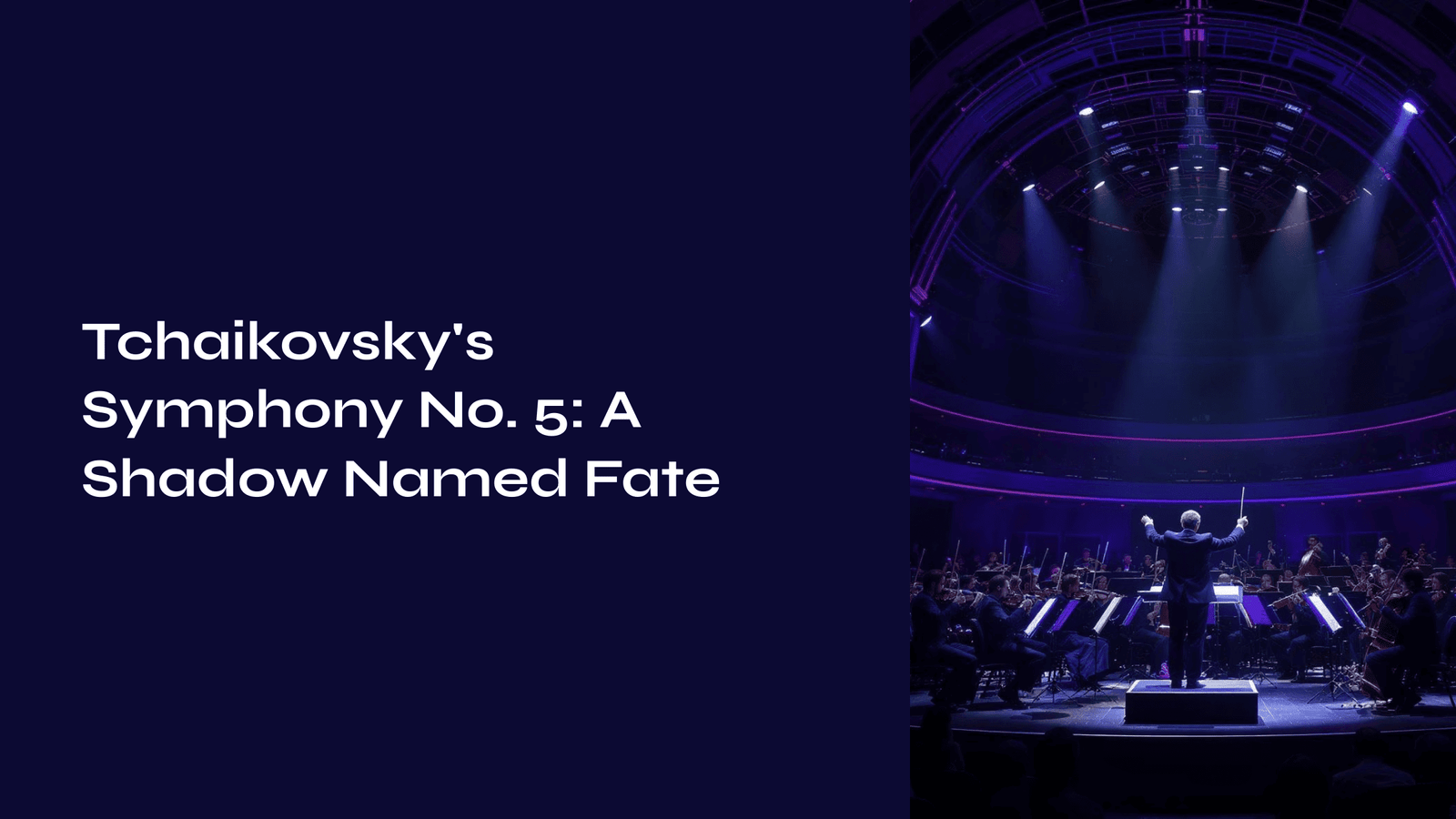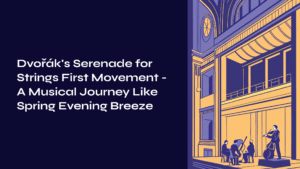Table of Contents
When a single clarinet phrase emerges quietly from the darkness, we already know. This is not merely a melody. It’s as if someone is peering into the depths of our hearts, whispering, “Haven’t you felt this moment too?” Those four notes. E-B-G-E. Tchaikovsky’s Symphony No. 5 begins like this. With a shadow named fate.
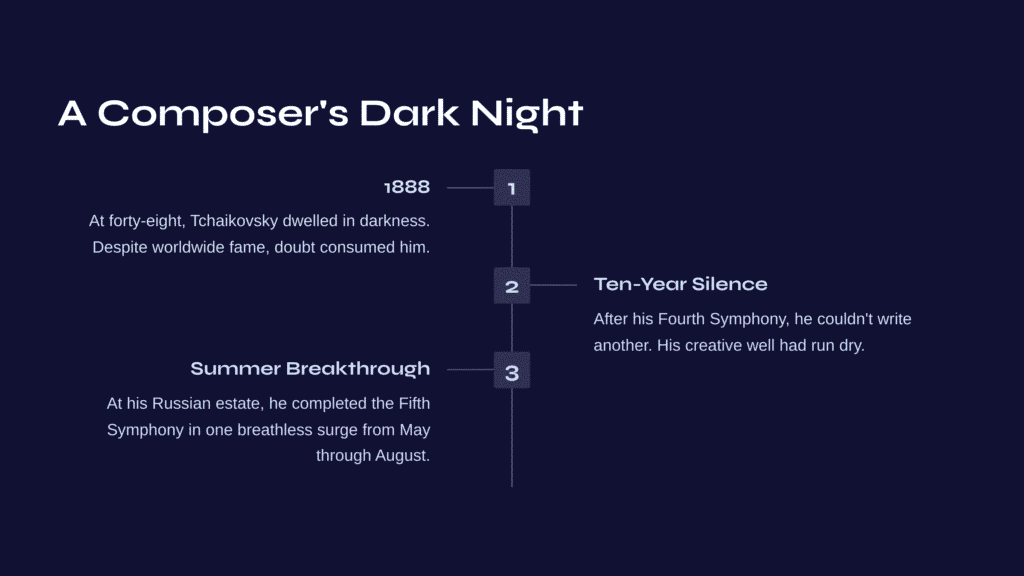
A Composer’s Dark Night, and Hours of Doubt
In 1888, Tchaikovsky dwelled in his own darkness. At forty-eight, having already achieved worldwide fame, his heart was consumed with doubt. “Can I truly compose anymore?” The despair in his letters to patron Nadezhda von Meck was laid bare with painful honesty.
A ten-year silence. After his Fourth Symphony, he found himself unable to write another. Like a well run dry. Yet sometimes it is from our deepest despair that the most beautiful art emerges. The Fifth Symphony stands as proof of this truth.
At his Russian country estate in Frolovskoye, he completed this work in one breathless surge from May through August. Complete resignation before fate, or helplessness in the face of inscrutable providence. These words, which he left in his sketches, became the philosophy that permeates the entire symphony.
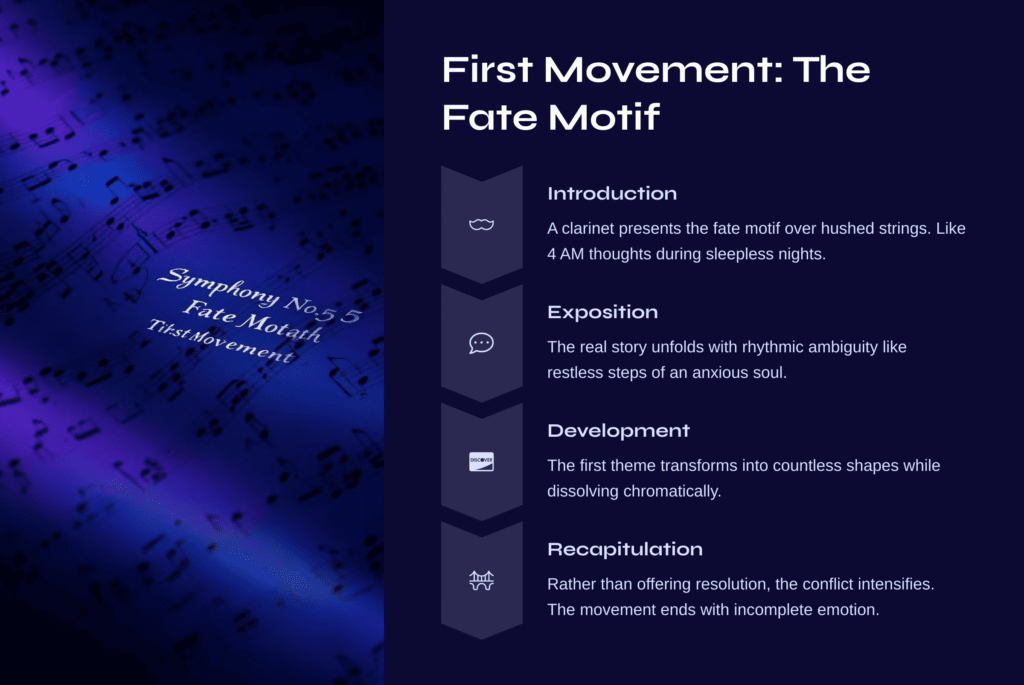
First Movement: The Fate Motif and Sonata Form Reimagined
Introduction – A Whisper from the Darkness
In the Andante introduction, a clarinet presents that famous fate motif over hushed string accompaniment. Just thirty-six measures, yet this brief moment determines the destiny of the entire symphony. Like an ominous premonition that suddenly appears, this theme will return transformed throughout all four movements.
Some have called it a funeral march, others the sound of fate knocking at the door. But for me, it strikes something more personal. Those 4 AM thoughts that surface in sleepless nights. “Is my life flowing in the right direction?” This is the music of precisely such moments.
Exposition – A Dialogue of Conflicted Hearts
When the Allegro con anima begins, the real story unfolds. The first theme, presented by clarinet and bassoon in E minor, carries rhythmic ambiguity like the restless steps of an anxious soul. This clever confusion between 6/8 and 2/4 meter keeps us perpetually on edge.
Then comes the second theme in B minor at measure 152. Above violin pizzicatos, woodwinds sing a lyrical melody. In this moment alone, both Tchaikovsky and we listeners find fleeting peace. But only briefly—at measure 170, a pastoral interlude appears, drawing our hearts toward yet another place.
Development – Themes Dissolving, Hearts Wavering
The development section reveals Tchaikovsky’s true mastery. The first theme transforms into countless shapes while dissolving chromatically. Particularly spine-chilling is measure 218, where the theme appears in D minor—a tritone away from the original E minor. This is fate’s destructive power made manifest.
Recapitulation and Coda – Unresolved Tension
Rather than offering resolution, the recapitulation intensifies the conflict. The first theme returns fortissimo in winds and brass, but dissonant suspensions in the strings darken it further.
And then the coda. The introduction’s mournful clarinet theme returns, but now transposed down a perfect fifth to A minor. This is musical “defeat.” The first movement ends leaving an incomplete emotional trajectory.
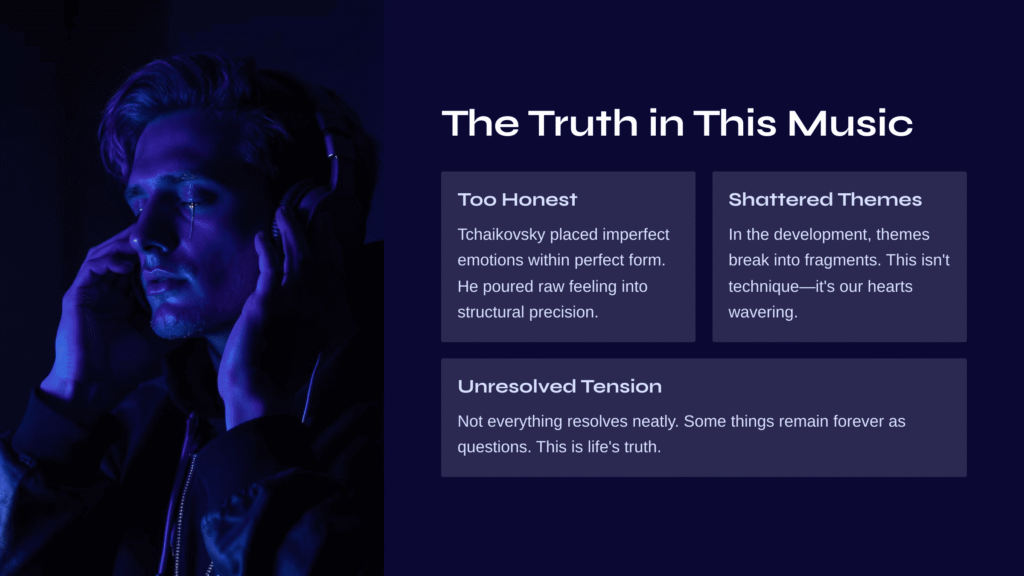
The Truth I Feel in This Music
Each time I listen to this music, I understand why Tchaikovsky doubted his own work. It’s too honest. Too human. He placed imperfect emotions within perfect form, poured raw feeling into structural precision.
Especially those moments in the development where themes shatter into fragments. This isn’t merely compositional technique—it’s the very sensation of our hearts wavering. Our oscillation between anxiety and certainty is etched into every note.
And that final unresolved tension. Isn’t this life’s truth? Not everything resolves neatly; some things remain forever as questions.
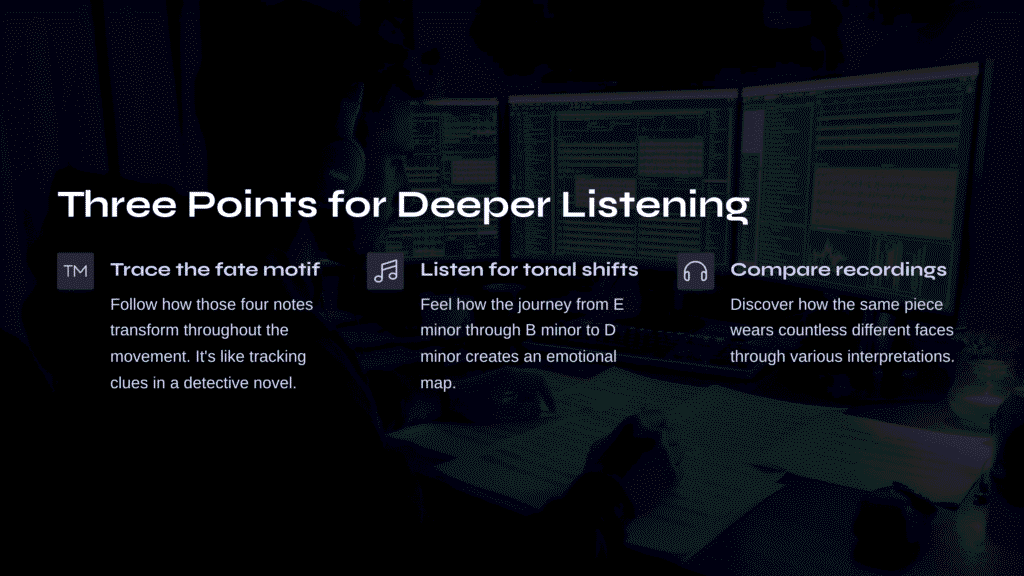
Three Points for Deeper Listening
First, trace the fate motif. Follow how those four notes from the introduction transform and weave throughout the entire movement. It’s as thrilling as tracking clues in a detective novel.
Second, listen for tonal shifts. Feel how the journey from E minor through B minor to D minor isn’t mere technique, but an emotional map.
Third, compare different recordings. Listen to interpretations like Valery Gergiev’s 1989 recording that emphasizes structural clarity against others that highlight dramatic tempo changes. You’ll discover how the same piece can wear countless different faces.
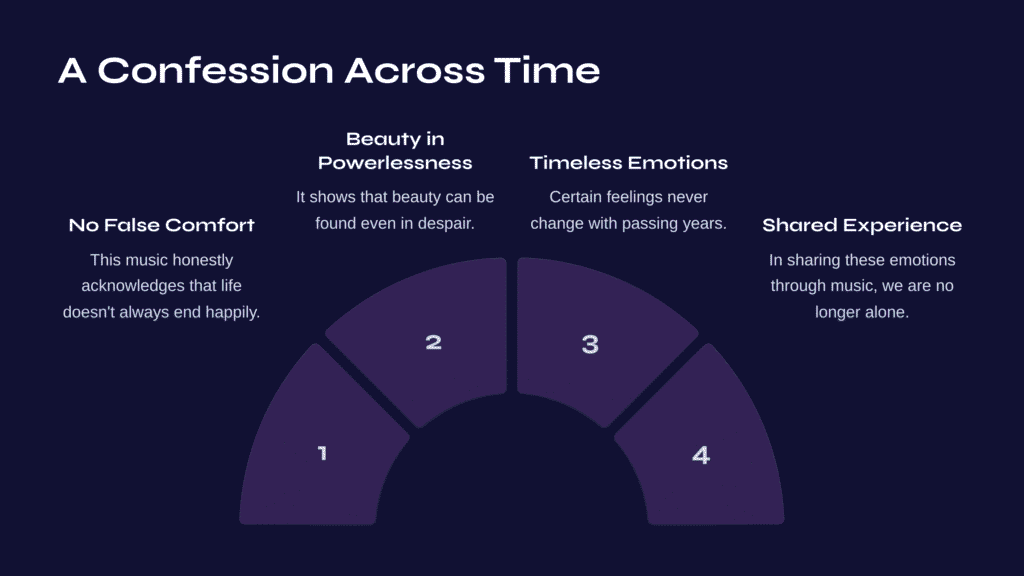
A Confession Across Time
Though Tchaikovsky doubted this symphony amid criticism that it was “overblown,” why do we remain captivated by this music 150 years later?
Because it offers no false comfort. It honestly acknowledges that life doesn’t always end happily, that sometimes we must feel powerless before fate. Yet simultaneously, it shows us that beauty can be found even in that powerlessness, that despair itself can become art.
When the clarinet’s final sigh dissolves into air, we understand. Why music transcends time. That certain emotions never change with passing years. And in sharing them, we are no longer alone.
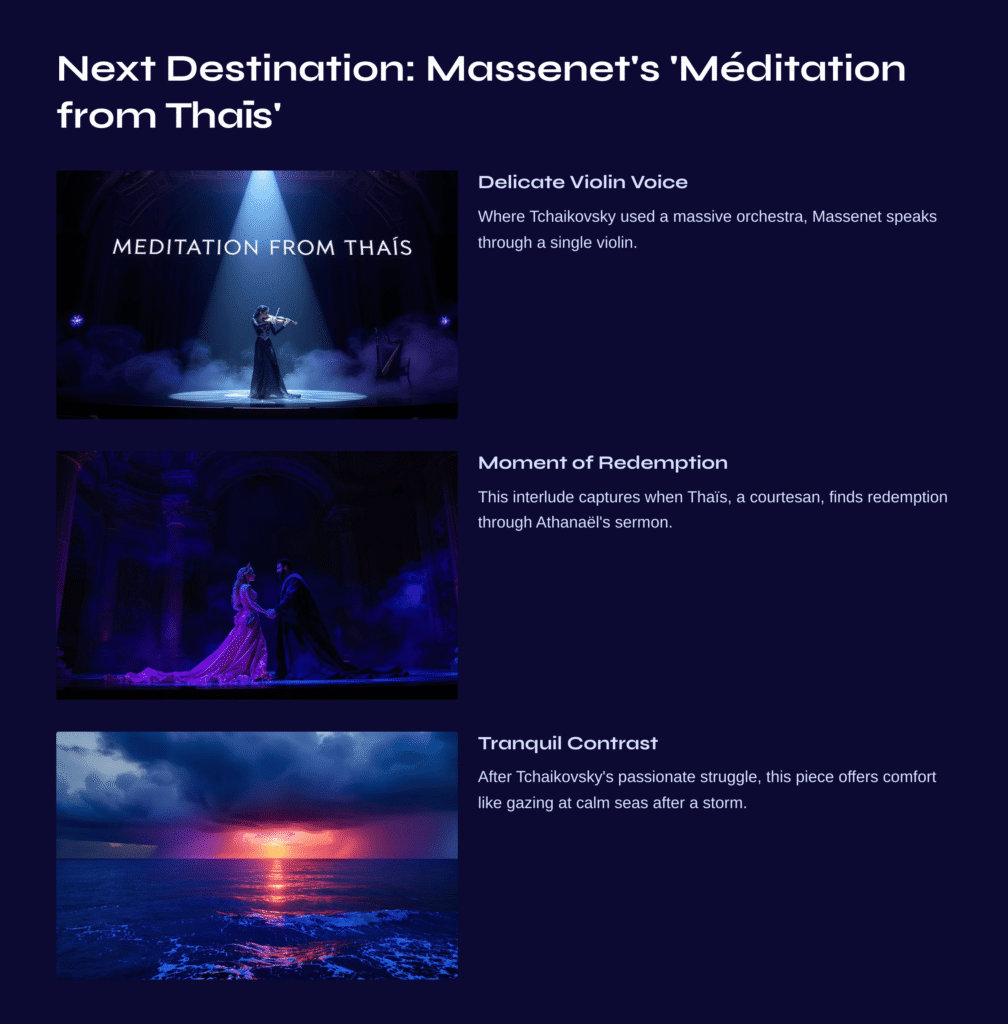
Next Destination: Massenet’s ‘Méditation from Thaïs’ – Between Sacred and Sensual
Shall we depart from Tchaikovsky’s weighty fatalism and journey to an entirely different world? The Méditation from Massenet’s opera Thaïs represents one of the most beautiful prayers ever offered by a single violin.
Where Tchaikovsky painted the human interior with a massive orchestra, Massenet sings of spiritual purification through the violin’s delicate voice alone. This piece serves as an interlude during the moment when Thaïs, a courtesan of Alexandria, hears the monk Athanaël’s sermon and finds redemption. It walks the boundary between worldly and divine love.
Though barely five minutes long, the emotional spectrum contained within is infinite. The violin’s melody above harp arpeggios sounds alternately like urgent prayer and sensual sighs. Rather than battling fate, this music speaks of surrender, of trusting in something higher. After Tchaikovsky’s passionate struggle, this piece’s tranquility offers the same comfort as gazing upon calm seas after a storm.
